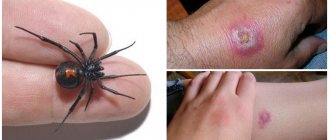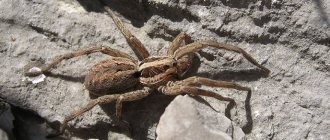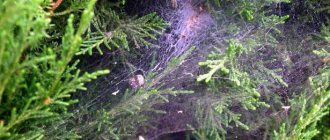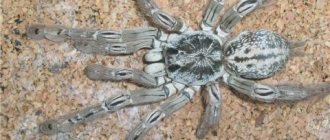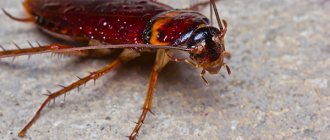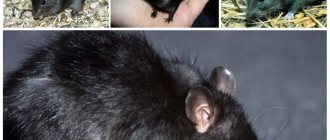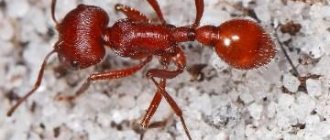What species can be found at the dacha
Spiders are predators, representatives of the animal world.
In summer cottages they are found everywhere: both in residential buildings and in nature. The table contains information about spiders that prefer close proximity to humans:
In the garden there are all the species listed earlier, as well as other arthropods: wasp spider, wolf spider, etc. Almost all of them are harmless to humans, but they can bite if they feel threatened.
Spider bites are most dangerous for children and people with weakened immune systems.
Ground spider in the garden
The living nature around us is represented by different types of animals, plants, fungi, and microorganisms. Each species exists as a community of a huge number of representatives.
The same applies to arachnids. More than a thousand species of spiders are common in nature, but people most often encounter two species that settle in houses, the gray spider and the black one. Although these animals are harmless and more often do good than harm, not all people are happy about such a neighborhood, so they begin to look for ways to get rid of spiders in private homes.
We get rid of them in a private house
To get rid of spiders, you need to create conditions for them in which they cannot exist and reproduce. To do this, the following measures should be taken.
Clear out the attic and basement
Most spiders get into the basement first and then scatter throughout the house. Your task is to create the most unfavorable conditions for them. To do this, just update the whitewash on the walls and ceiling. Arachnids cannot stand the smell of lime, so they avoid such premises for a long time.
Destroy other insects
Spiders come to those houses where there is food. By destroying flies, mosquitoes, ants and cockroaches, you will deprive uninvited guests of food and force them to leave the premises. To combat insects, you can use folk remedies and household chemicals. A universal fumigator will be a good help in this matter.
Clear the area around the house
The easiest way for a spider to get into a room is to move there on objects and plants located near the building. Therefore, the space near the house needs to be cleaned: remove weeds, fallen leaves, building materials, and abandoned objects.
Clean up the house
The cleaner the house, the less often spiders appear in it, so cleaning is an integral step in getting rid of arthropods. The first thing to do is vacuum all horizontal and, if necessary, vertical surfaces. Particular attention should be paid to cracks, corners, baseboards and secluded places behind furniture.
Sometimes spiders make nests at the bottom of beds, inside sofas and armchairs. Another way to remove cobwebs is to use a mop wrapped in a damp cloth or gauze.
Block all possible access routes
To prevent the spider from getting into the house, you need to inspect all the openings leading inside: seal the cracks along the windows and doors, repair the ventilation grilles, install mosquito nets, and seal the pipe openings.
Chemicals
To radically combat spiders in the house, chemical agents are used:
"Raptor"
Spray against crawling insects with instant action and long-lasting effect. It has a distinct mint scent and is applied to areas where spiders gather, their routes of movement and habitat areas (cracks, baseboards, spaces between walls and furniture). The distance between the bottle and the surface to be treated should be about 20 cm.
Joker Bun
A universal drug that destroys all types of insects. The aerosol is sprayed onto the floor, walls, corners, crevices, furniture and other places where spiders can hide. Before treatment, windows and doors are closed, people and animals are removed from the premises. Half an hour after spraying the product, the house is thoroughly ventilated.
How to get rid of spiders in a country house
These unpleasant-looking predators do not pose a threat to people, except those that belong to poisonous species, and in fact bring invaluable benefits to humans, destroying flies, moths, mosquitoes, midges and other harmful insects.
At the same time, spiders are incredibly voracious, eating daily as much food as they weigh. Another thing is that, having settled inside the home, these arthropods begin to litter the walls and ceilings with cobwebs, making them unsightly. Therefore, the purely aesthetic side of the issue is already a reason to get rid of such an unpleasant neighborhood. In addition, in many people, spiders cause arachnophobia (fear of arachnids), which is one of the most common phobias that have survived from the times when primitive people were forced to live in caves.
There are various ways to get rid of spiders, but there are two main approaches:
· Humane, or a method that allows you to catch spiders without taking their life
· Inhumane method (the name speaks for itself)
However, before you begin to physically destroy or catch uninvited guests, it is necessary to close all loopholes through which spiders can enter the house. For this purpose, it is advisable to seal all the cracks in window and door frames, seal holes around electrical wiring, and check the ventilation and heating systems.
The hearing organs of spiders are hairs that grow on their legs and have the ability to pick up sounds. Using the same sensitive hairs, spiders can detect odors.
In order not to kill these representatives of arthropods, you can try to catch them using an improvised trap. Any utensil (kitchen container, jar, cup or glass) is suitable for this purpose. In this case, it is advisable to use a container that is not too heavy and not very fragile. The trap should be comfortable to hold in your hands, and it is better if the walls are transparent.
Next, we suppress the feeling of fear and disgust, be patient and try to catch the spider using this simple device. You need to act quickly and confidently.
As soon as the trap is triggered and the spider is inside the dish, it must be quickly covered with a lid or a regular sheet of paper so that the “prisoner” cannot escape.
Next, the spider should be released alive and unharmed so that it can continue to catch various pests. You just need to take it a sufficient distance from your home so that it doesn’t return to the house.
The world's largest spider is the Goliath tarantula spider, which was first discovered in Venezuela in 1965. The span of its paws reaches 28 cm.
The web along with the spider can be easily removed using a damp broom or a wet rag tightly wound around a mop. In this simple way, it is advisable to treat corners, crevices and all secluded places where these arthropods can live.
Regular wet cleaning of the premises will also prevent the appearance of unwanted guests in the house.
A regular vacuum cleaner is also a good help for fighting spiders.
The spider's brain occupies on average one quarter of its body in volume.
· Cleaning the room with vinegar solution
Various insecticides or acaricides, which are usually used to combat cockroaches, ticks, moths, etc., are also effective in controlling spiders. However, it is undesirable to use potent chemicals indoors unless absolutely necessary. After all, they are all substances of different hazard classes and can lead to health problems in people, and if there are pets in the house, they can also harm them. In addition, industrial aerosols are often quite expensive products. Therefore, you can use home remedies.
For this purpose, a solution of ordinary acetic acid is suitable, which should be pre-mixed with water in a 1:1 ratio, and then poured into a spray bottle and used to fight spiders.
In this case, it is advisable to treat all secluded places where arthropods can live. This should be done carefully, especially if there is varnished furniture in the room, since its surface may be damaged as a result of contact with vinegar.
At one time, a female spider can lay several thousand eggs at once.
· Treat the room with essential oils
Instead of a vinegar solution, you can use natural essential oils, such as cinnamon, peppermint or tea tree, as a filler for the diffuser. To obtain a working solution, take 20 drops of oil and mix with 700 ml of water.
To prevent spiders from getting used to one scent, it is advisable to alternate essential oils.
Singapore spiders are capable of creating a copy of themselves in the form of a dummy from various small debris caught in their webs. Thus, when arthropods are attacked by wasps that hunt them, they first attack the “fake”. In the meantime, the spiders manage to retreat and hide.
How to get rid of it in the garden
If arachnids have chosen bushes and trees, it is worth thinking about what exactly attracted them to the site. In most cases, these are a variety of pests attracted by organic debris or bright outdoor lighting. You can eliminate the cause by installing yellow-light sodium gas-discharge lamps and clearing the area of anything that can serve as food for insects (last year's leaves, tops, rotting fruits and vegetables).
The next step should be to destroy the nests, which look like small balls shrouded in cobwebs. By doing this, you deprive the spider of offspring and prevent it from reproducing.
Folk remedies
It is not recommended to use chemicals to exterminate spiders in the garden, as it is expensive and has a detrimental effect on the pollination process of plants.
The optimal solution would be to use folk remedies:
Mint and lavender
In order for spiders to leave the territory, it is enough to plant any of the listed plants on it. If desired, flowerpots with mint and lavender can be placed around the entire perimeter of the site.
Chestnut
Collect horse chestnut fruits. Break or pierce them to intensify the smell. Place it on the site.
Tobacco
Boil 4 liters of water, add a pack of smoking or chewing tobacco. Infuse, strain through a sieve or cheesecloth. Take 200 ml of the prepared product and add 100 ml of lemon-scented dishwashing gel. Mix thoroughly and pour into a spray bottle, treat the area. Do not use near beds where tomatoes are growing.
The need for spiders in our lives
Benefits brought by spiders
The most important benefit that spiders bring is the destruction of harmful insects. Spiders are voracious creatures; every day each spider eats as much food as it weighs. For example, the cross spider is capable of catching and eating up to 500 insects in its net per day, most of which are flies. And there’s no need to talk about the dangers of flies.
Possible harm from spiders
Of course, everyone who is afraid of spiders is afraid of being bitten.
But only a few species of poisonous arachnids pose a danger to humans; most spiders living near us are absolutely harmless. And the biggest harm they cause is their unaesthetic appearance and ugly cobwebs in the corners of the house. This is also interesting: The best remedies against arachnids
Every person encounters spiders every day. And everyone chooses for themselves this or that behavior in relation to these animals. Before you raise your hand and kill the little spider, remember that very often simple fears tell us that spiders are more friends for people than enemies. Maybe it would be easier to take him to a place that is safe for him and let him go?
What not to use for fighting
When exterminating spiders, you should avoid using the following methods:
If there are few spiders in the dacha and they do not cause discomfort, there is no need to exterminate them. In nature, arthropods perform an important function by reducing insect populations and protecting plants from pests. This recommendation does not apply to areas with large numbers of spiders. The magazine “Super Summer Resident” recommends: “when a large space is covered with cobwebs, you should contact the sanitary service.”
What does NOT work against spiders in the country
To solve the problem of how to get rid of spiders in your summer cottage with maximum efficiency, you need to understand that spiders are not flies and mosquitoes. These are creatures of a completely different species.
It is worth considering for the most “desperate” that even an ordinary cross can bite more painfully than a bumblebee or a hornet, and the risk of developing an allergic reaction to a bite is many times greater.
Among the descriptions of control methods, how to get rid of spiders in a summer cottage , there are frankly ridiculous pieces of advice. For example, spiders will most likely ignore a fly treated with dichlorvos, because Their sense of smell is really well developed. The corpses of other spiders do not in any way frighten their living relatives and they do not run away from the beds due to “stress.”
How to get rid of tarantulas? And is it worth it?
Spiders in the house and in the country: is the neighborhood safe?
Adding an article to a new collection
For unknown reasons, it is spiders that evoke some irrationally unpleasant feelings in the vast majority of humanity - disgust, fear, disgust. With a high degree of probability, any summer resident, unexpectedly seeing such a “neighbor” on the porch, in the basement or in the room, will try, first of all, to slam him.
Let's try to use logic and figure out what types of spiders there are in our areas, where and why they get into the house, and why you shouldn't kill every spider you meet, even if its appearance doesn't make you very happy.
We will not mention poisonous exotics from the south of Russia like the South Russian tarantula or karakurt; in this material we will make do with listing the most common species of spiders that you can easily see in the middle zone, in the same Moscow region.
Funnel spiders (Agelenidae), house and labyrinth
Funnel spiders: house spider on the left, labyrinth on the right
Representatives of this family are frequent inhabitants of cellars and basements of residential buildings around the world.
The house spider (Tegenaria domestica) is usually tan in color with a "pattern" on the back, its slightly hairy body can be more than a centimeter long, and its darker legs are about twice as long as the body. Females are usually slightly larger, thicker, and shorter-legged than males.
House spiders build their rather large flat webs with a funnel-shaped indentation at one end in dark places. They themselves sit in these very “funnels”, waiting for prey, small insects - moths, flies, cockroaches. When prey gets caught in the net, they quickly rush at it and kill it. These spiders use their web for about two to three weeks, after which they leave it and weave a new one. Outdoors they can live in thick grass, wood cracks, among dry bushes, etc.
Jumping spiders (Salticidae)
Different types of jumping spiders
You have probably also seen these “fluffy” medium-sized and compact spiders with large eyes and powerful legs. They easily climb vertical surfaces, including “inconvenient” ones like glass. They can often be seen near human habitation on stone and brick walls, where they bask in the sun. These spiders are also found in thick grass. The color of these arachnids can be very different - black, light brown, striped, spotted.
Jumping spiders are active daytime hunters; they do not weave webs, but track prey (insects and the smallest vertebrates) and jump at it, often over long distances.
Jumping spiders that live in our latitudes are absolutely safe and not poisonous to humans.
Traditional methods of getting rid of spiders
Peppermint oil is an affordable way to fight spiders.
In addition, it has a pleasant smell and does not cause harm to people and pets. Many summer residents have successfully noticed that spiders are repelled by certain aromas.
- It is difficult to notice arthropods where horse chestnut fruits are spread out. To make the effect more effective, it is better to break the peel or pierce it so that the smell intensifies. Coumarin glycosides, which are contained in the core of the fruit, have low, but quite sufficient toxicity to clear the room of spiders.
- People use all parts of nuts - branches, leaves, fruits and their peel. It has long been known that tannins with a tart odor act as a repellent on insects and spiders. If a walnut is planted near the house, then there are much fewer flies, mosquitoes and spiders there.
- Where dry citrus peels are laid out in the room, spiders do not linger.
- Diffusing peppermint oil gives good results. A few drops of oil should be added to the water and sprinkled on the areas where the spiders are supposed to live. To enhance the effect and extend the life of the solution, you can dip cotton wool or a soft cloth into it and wipe it across the baseboards. If you don’t like the smell of peppermint and cause allergies, you can replace it with tea tree oil or eucalyptus leaves. The recipe for use is the same as with mint.
- It is believed that when a vinegar solution comes into contact with spiders, their integumentary tissues burn, causing them to die. This occurs by directly spraying liquid on spiders or in areas where they live. The sour smell drives them away even from a distance. You can place small vessels with acetic acid in dark corners, this will also help get rid of spiders.
Hay-making spiders, or long-legged spiders (Pholcidae)
Among these small spiders there are many synanthropic species - that is, they are the ones you can easily find in a person’s home.
They have a pale, naked body several mm long with a constriction stalk at the point of transition from the abdomen to the cephalothorax, and the length of the legs can exceed the body size by 20 times, for which the harvestmen are given the name “long-legged”.
Haymaking spiders are predators; they feed on all sorts of creeping and flying little things, which they catch in their randomly woven webs, where they can hang motionless upside down for hours. You can notice these cobwebs in dark, dry and warm corners of rooms (usually abandoned or rarely visited). Spiders can also settle in the open air - in hollows of trees, under stones and dead wood, etc.
Of course, these little ones are not at all dangerous for humans and, when they meet them, they will first of all try to run away and hide.
In the Arachnida class, in addition to the Spiders order, to which the above-described centipedes belong, there is another separate order, Haymakers. Many people know these arthropods under their childhood nickname “braidtail”. They have the same long legs, but the abdomen is segmented and connected to the cephalothorax by a wide base, and not by a “stalk” like a spider. Mosstails feed on small insects, as well as plant tissues, and are absolutely safe for humans! And the mechanism of independent contraction of severed limbs helps the harvester to distract predators in order to have time to run away and hide.
How to get rid of spiders in your summer cottage
Larger species of arachnids, such as crosses, tarantulas and others, settle in garden plots.
In the garden
In summer cottages, spiders most often settle in greenhouses, since the most favorable conditions are created for them there and there is always food.
In the garden or flower garden
When fighting spiders in the garden or flower garden, you can apply all of the above measures individually or in combination. The main thing to remember is that the use of chemicals is not advisable during flowering , since bees and other flower-pollinating insects will suffer in large quantities from the chemicals.
Yellow pouch spider or chirocontid (Cheiracanthium punctorium)
Yellow sac spider
These spiders are quite rare and prefer to live in very dry, hot climates, which is why they are more often found in Asia. However, recently, apparently due to climate change, cases of their detection have become more frequent not only in Eastern, but even in Central and Western Europe, so knowing the “enemy in person” will be useful.
Why enemy? Because meeting him, of course, will not be fatal, but it will cause you trouble. Its bite is not only deep and painful, but can also cause unpleasant symptoms such as nausea, swelling, chills, fever and increased blood pressure. Usually painful symptoms disappear within 24-30 hours, otherwise hospitalization is necessary.
The size of this spider is average, about 1-1.5 cm, it has a yellow-brown or greenish dense body, somewhat pointed towards the rear end, strong legs and powerful chelicerae (oral “biting” appendages).
This spider lives in grassy and bushy thickets and can hide in leaves rolled into tubes. It does not weave a wide web, but attacks victims (insects, ticks, small caterpillars) in a jump. Females that lay eggs in tall grass may aggressively defend their cocoons.
Video tip: how to remove spiders from your home
Source
| A ubiquitous species. Lives in trees and almost does not reproduce at home. Often found in rooms where it enters through open windows and vents. The size of the female reaches 3 cm, the male – 1.5 cm. | |
| Harvester, long-legged or moss-legged | Lives in the garden (often on the external walls of houses), but with the onset of cold weather it moves indoors. It has a brown oval body up to 1 cm long and long legs. Prefers to live next to windows, feeding on midges and flies. |
| Hobo Spider | Lives on the street, but is also found in houses, getting there through open doors and windows. It has a brown color and dark stripes on long powerful limbs. The bite of such a spider causes pain and an allergic reaction. |
Orb-weaving spiders (Araneidae), crossworts and argiopes
Orb weavers usually live on tall shrubs and trees in forest ecosystems, although they can also be found in populated areas.
These spiders are very diverse in size, body shape and color, so it is quite difficult to create a general description.
Of this family, people are most familiar with crosses - they got their name due to the pattern of their thick abdomen, where, against a darker background, light spots form a figure similar to a cross. The body size of these brown, gray, black arthropods is usually 1-2 cm, and the body covering is waxy.
At the end of summer and autumn, large nets-“wheels” of crosses are visible everywhere - in the forest, in gardens, on hedges, under the roofs of buildings, in the darkened corners of buildings, in the window frames of abandoned houses. The fact is that juveniles begin to build nets in the spring, increasing them month after month. These spiders feed on flying insects and are safe for humans - their possible bite, by medical standards, is no more dangerous than a mosquito bite.
Knitting spiders, or tetragnathids (Tetragnathidae)
These spiders prefer to settle on vegetation in damp meadows and forest edges, often on grass and bush branches along water bodies.
Knitters have an elongated, brown or gray, often shiny body 6-12 mm in length, and long legs are often extended back and forth in pairs, mimicking and visually turning into a “stick”.
Tetragnathids build round trapping nets (both horizontal and vertical), often with a hole in the center or very large rectangular cells, feed on insects (mainly mosquitoes and flies), and do not pose any danger to humans.
How to get rid of spiders indoors
In a private house
Like all other animals, spiders prefer to settle where there is enough food for them. Their food includes flies, cockroaches, moths, earwigs, ants and other small insects. Therefore, you need to start the fight against spiders by destroying their potential food :
Sprinkle acid in spider habitats.
In the country
All of the above measures also apply in country houses.
However, very often cottages have a basement and attic, which should also be taken care of when fighting spiders.
Silver spider or water spider (Argyroneta aquatica)
This is the only European aquatic species of spider, so you will not confuse it with anyone else.
Their body is round, gray or brown, up to 15 mm in length, covered with many velvety hairs. They also differ from other spiders in having long swimming bristles on the hind legs and three claws on the legs of the three hind pairs.
Silverfish are often found in still or slow-moving waters. It feeds on various small animals that become entangled in the threads of its underwater web or which it catches while swimming in the water.
A water spider bites very rarely and only for the purpose of self-defense. A person can be injured accidentally by being pulled out of the water along with fish or aquatic plants. Redness, pain, burning, swelling, and swelling appear at the site of the bite. People prone to allergies, with weak immune systems, and young children may experience a deterioration in their health after a spider bite - weakness, nausea, dizziness, headache, and fever. The condition returns to normal in a few days. To speed up the therapeutic effect, take antihistamines.
In some places, silverfish are included in the regional Red Books of Russia and are protected!
What do spiders look like?
To begin with, it is worth saying that spiders (Araneae) are not insects. Insects are food for spiders. Both are arthropods. However, in addition to spiders and insects, arthropods also include centipedes and crustaceans. Spiders are classified into a separate class - Arachnids. However, even within this class, spiders are not the only ones. So, garden haymakers (kosinozhki), which look like spiders, are not spiders at all, but neighbors in the class, the order of haymakers. There, in the neighbors, there are ticks, scorpions and some other creatures similar and dissimilar to spiders. Spiders are in their own squad, simply called “spiders”.
In general, all types of spiders look similar. The body is divided into two parts: the anterior cephalothorax with four pairs of legs, protected by a durable chitinous shell (exoskeleton), and a soft abdomen carrying internal organs. They are connected by a thin tube - a stem. Each leg consists of 7 segments, that is, there are 6 “knees” on each leg.
Spiders have not only rich knees, but also eyes: there are 12 eyes, most species have 8, some have 6, and rarely 2. Therefore, vision in terrestrial species is good, only in cave species it is bad, but they don’t need it. But no species has ears or a nose, but there are sensitive hairs on the legs that perceive air vibrations, smell and taste.
The front part of the spider, due to the hard outer covering, cannot grow, unlike the soft abdomen (well, everyone’s abdomen grows well!), so spiders are forced to change this shell several times to a larger size. Like all moults, this process is not easy, it requires a hunger strike and removal to quiet, protected places, where the spider emerges from the tight old skin in a new, but still relatively soft shell. It also takes some time to strengthen it. All this time, the spiders are quite vulnerable, which is why they hide.
Spider (Araneae). © davidh-j
Crab spiders, or sidewalkers (Thomisidae)
These representatives of arthropods are distinguished by a very swollen spherical abdomen against the backdrop of thin legs.
The color of their body (up to 10 mm long) can be nondescript white, greenish, beige, or, conversely, very bright - two-color, patterned, striped. The first two pairs of legs of these spiders are usually much longer than the hind ones.
Crab spiders can move sideways, which is why they got their nickname. They do not build trapping nets, but lie in wait for their prey (insects and small spiders), sitting on flowers, on leaves, in litter or on the bark of trees. They are absolutely not dangerous for humans.
